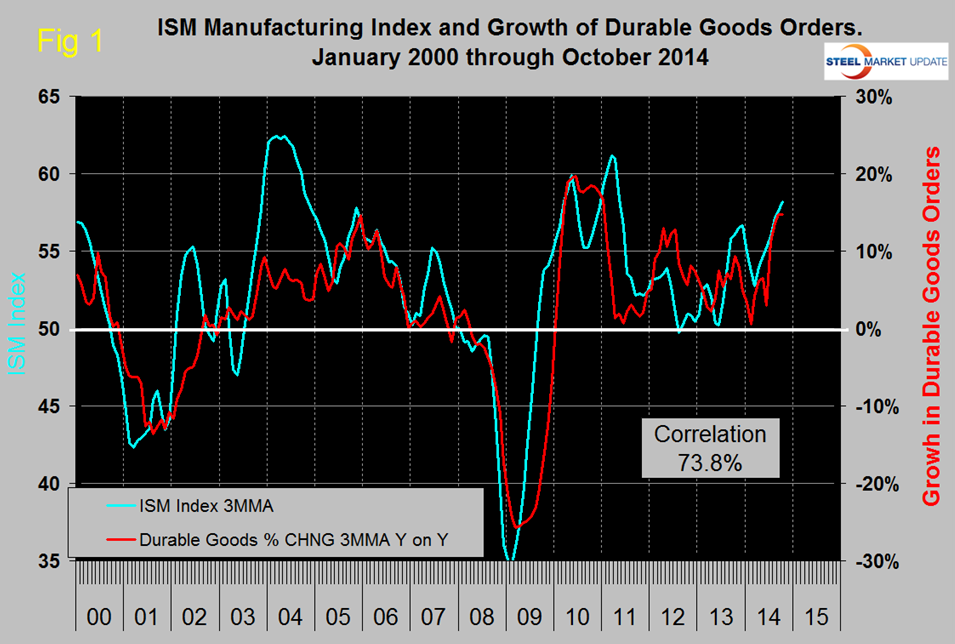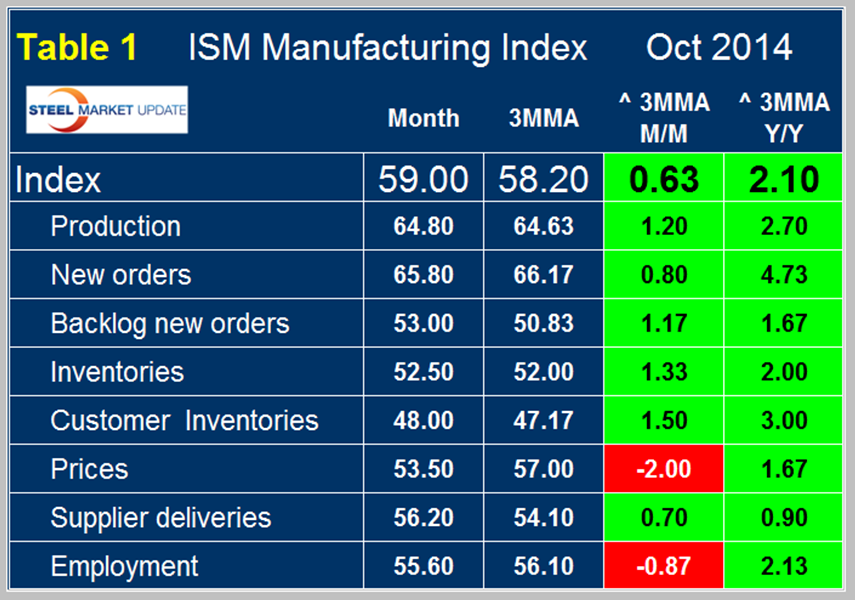Economy
Manufacturing Continued to Advance in October
Written by Peter Wright
November 4, 2014
The Institute of Supply Management released their October report on November 2nd and the report surprised analysts on the upside. The October purchasing managers index, PMI registered 59.0 up from the 56.6 reading in September and equal to the August result. Any number >50 indicates expansion and this was the seventeenth straight month in which this was the case. The three month moving average, (3MMA) advanced from 57.57 in September to 58.2 in October, this was the twenty fifth consecutive month of a value >50 in the 3MMA. This month we decided to review the relationship between the ISM manufacturing index and durable goods orders, (Figure 1). We found the correlation to be 73.8 percent with no discernible lead / lag relationship between the two, but the correlation is encouraging in that the growth of each is supported by the other independent data set.
Table 1 shows the break down for October by sub component with the monthly result, the 3MMA, the growth of the 3MMA month over month and year over year for each. Based on the comparison of the 3MMA in both time periods the index is slowing but this isn’t surprising since it is approaching 60. The index has exceeded or equaled 60 only 14 times in the 166 months since January 1997, which is as far back as our data goes. Of the sub-components, prices and employment declined but there is, as yet, no negative trend in either.
The official news release reads as follows:
New Orders, Employment and Production Growing, Inventories Growing, Supplier Deliveries Slowing
Economic activity in the manufacturing sector expanded in October for the 17th consecutive month, and the overall economy grew for the 65th consecutive month, say the nation’s supply executives in the latest Manufacturing ISM Report On Business.
The report was issued today by Bradley J. Holcomb, CPSM, CPSD, chair of the Institute for Supply Management (ISM) Manufacturing Business Survey Committee. “The October PMI registered 59 percent, an increase of 2.4 percentage points from September’s reading of 56.6 percent, indicating continued expansion in manufacturing. The New Orders Index registered 65.8 percent, an increase of 5.8 percentage points from the 60 percent reading in September, indicating growth in new orders for the 17th consecutive month. The Production Index registered 64.8 percent, 0.2 percentage point above the September reading of 64.6 percent. The Employment Index grew for the 16th consecutive month, registering 55.5 percent, an increase of 0.9 percentage point above the September reading of 54.6 percent. Inventories of raw materials registered 52.5 percent, an increase of 1 percentage point from the September reading of 51.5 percent, indicating growth in inventories for the third consecutive month. Comments from the panel generally cite positive business conditions, with growth in demand and production volumes.”
Of the 18 manufacturing industries, 16 are reporting growth in October in the following order: Plastics & Rubber Products; Textile Mills; Fabricated Metal Products; Miscellaneous Manufacturing; Primary Metals; Electrical Equipment, Appliances & Components; Nonmetallic Mineral Products; Food, Beverage & Tobacco Products; Chemical Products; Apparel, Leather & Allied Products; Printing & Related Support Activities; Transportation Equipment; Furniture & Related Products; Paper Products; Machinery; and Computer & Electronic Products. The only industry reporting contraction in October is Petroleum & Coal Products.
What respondents are saying…
– “Holiday orders are exceeding seasonal forecasts. Customers are demanding additional quantities above prior orders. Fuel costs and other positive signals appear to be creating demand above normal.” (Food, Beverage & Tobacco Products)
– “Weakness in commodity prices very positive on our business.” (Fabricated Metal Products)
– “We continue to see strong demand across multiple sectors.” (Transportation Equipment)
– “Business steady and strong.” (Furniture & Related Products)
– “Another strong month in terms of business growth.” (Computer & Electronic Products)
– “Most business segments are seeing an upward trend in orders — mostly from existing customers, but also some new customers. Transportation continues to be a major issue.” (Chemical Products)
– “Conditions are still basically flat.” (Printing & Related Support Activities)
– “Production is oversupplying demand, and prices have softened.” (Wood Products)
– “Outer body material changes in the auto industry means new equipment and manufacturing growth.” (Machinery)
– “Business conditions are good; sales and production volumes are generally increasing.” (Miscellaneous Manufacturing)
Moody’s summarized as follows in Economy.com: “The ISM manufacturing index sharply rebounded in October, rising 2.4 points to 59, well ahead of the consensus forecast for a modest increase to 56.8. Our forecast for accelerating factory production through the remainder of this year remains in place. Manufacturing should get a boost from business investment, which appears to be strengthening. Also, the geopolitical tensions haven’t rattled U.S. business sentiment and the direct impact on trade has been minimal. The bigger concern is the lack of improvement in the euro zone economy and weakness in China. Encouragingly, anecdotes suggest labor has been in short supply in recent months. A tighter labor market should lead to higher manufacturing wages, as businesses will have to increase pay to attract the workers needed.
Explanation: The Manufacturing ISM Report On Business is published monthly by the Institute for Supply Management, the first supply institute in the world. Founded in 1915, ISM exists to lead and serve the supply management profession and is a highly influential and respected association in the global marketplace. ISM’s mission is to enhance the value and performance of procurement and supply chain management practitioners and their organizations worldwide. This report has been issued by the association since 1931, except for a four-year interruption during World War II. The report is based on data compiled from purchasing and supply executives nationwide. Membership of the Manufacturing Business Survey Committee is diversified by NAICS, based on each industry’s contribution to Gross Domestic Product (GDP). The PMI is a diffusion index. Diffusion indexes have the properties of leading indicators and are convenient summary measures showing the prevailing direction of change and the scope of change. A PMI reading above 50 percent indicates that the manufacturing economy is generally expanding; below 50 percent indicates that it is generally declining. A PMI in excess of 42.2 percent, over a period of time, indicates that the overall economy, or gross domestic product (GDP), is generally expanding; below 42.2 percent, it is generally declining. The distance from 50 percent or 42.2 percent is indicative of the strength of the expansion or decline. With some of the indicators within this report, ISM has indicated the departure point between expansion and decline of comparable government series, as determined by regression analysis.

Peter Wright
Read more from Peter WrightLatest in Economy

Steel groups welcome passage of budget bill
Steel trade groups praised the passage of the Big Beautiful Bill (BBB) in Congress on Thursday.

Industry groups praise Senate for passing tax and budget bill
The Steel Manufacturers Association and the American Iron and Steel Institute applauded the tax provisions included in the Senate's tax and budget reconciliation bill.

Chicago PMI dips 0.1 points in June
The Chicago Purchasing Managers Index (PMI) slipped 0.1 points to 40.4 points, in June.

Multi-family pullback drives housing starts to 5-year low in May
US housing starts tumbled in May to a five-year low, according to figures recently released by the US Census Bureau.

Architecture firms still struggling, ABI data shows
Architecture firms reported a modest improvement in billings through May, yet business conditions remained soft, according to the latest Architecture Billings Index (ABI) release from the American Institute of Architects (AIA) and Deltek.


